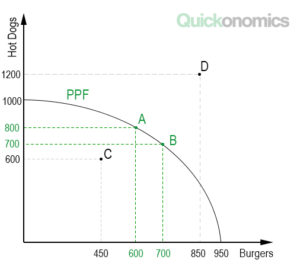Published Jan 17, 2023 The Production Possibility Frontier (PPF) is a graphical representation of the maximum possible output combinations of two goods or services an economy (or individual) can achieve when all resources are fully and efficiently employed. That means it illustrates the trade-offs people face when they have to decide how to allocate their resources between two different production activities. To illustrate this, let’s look at a simple example. Imagine an economy that produces two goods: hot dogs and burgers. The PPF of this economy is a curve that shows the maximum possible output combinations of cars and computers it can produce when all resources are fully and efficiently employed (see below). That means, if the economy produces 1000 hot dogs, it cannot produce any burgers. Meanwhile if it produces 950 burgers, does not have any resources left to produce hot dogs. Now, let’s assume the economy produces 800 hot dogs and 600 burgers. In this case, it is said to be operating at a point on the PPF (A). The same goes for the production of 700 hot dogs and 700 burgers (B). Meanwhile, at 600 hot dogs and 450 burgers, the economy could produce more and thus is not using its resources effectively. Finally, if the economy wanted to produce 1200 hot dogs and 850 burgers, it cannot currently do that because this output is outside its PPF (D). The production possibility frontier is an important concept in economics because it illustrates the trade-offs an economy faces when it has to decide how to allocate its resources between two different production activities. It also helps to illustrate the concept of opportunity cost, which is the cost of an alternative that must be forgone in order to pursue a certain action. Thus, the PPF is a useful tool for policymakers when it comes to making decisions about how to allocate resources in an economy.Definition of Production Possibility Frontier
Example

Why Production Possibility Frontier Matters
Basic Principles